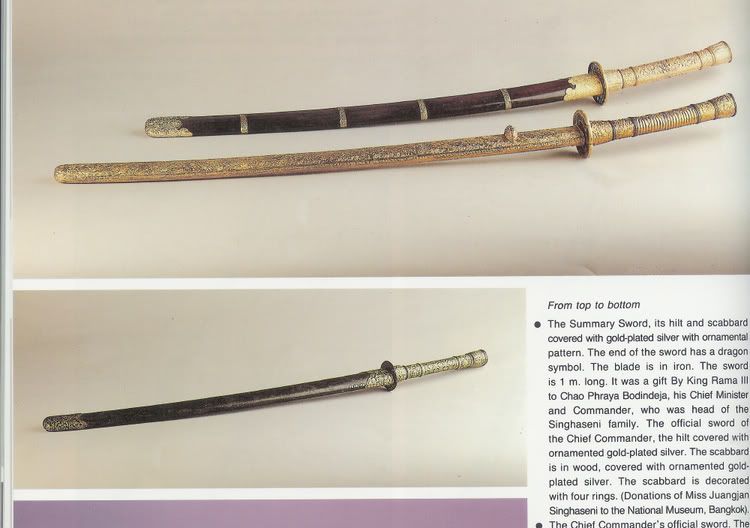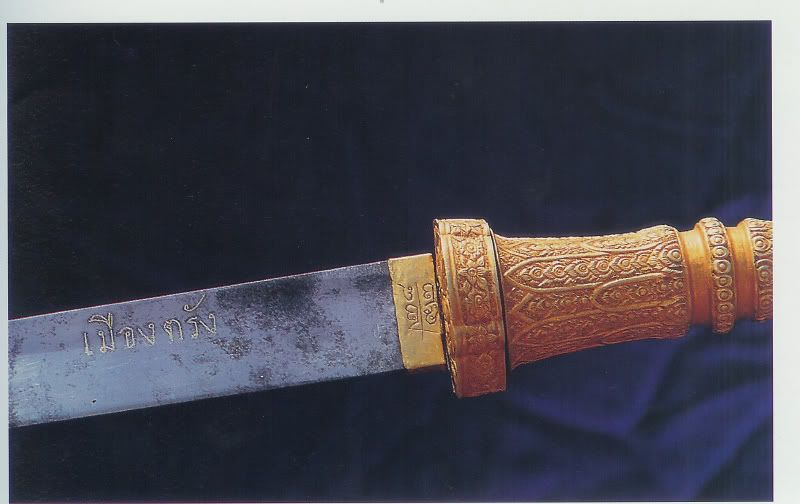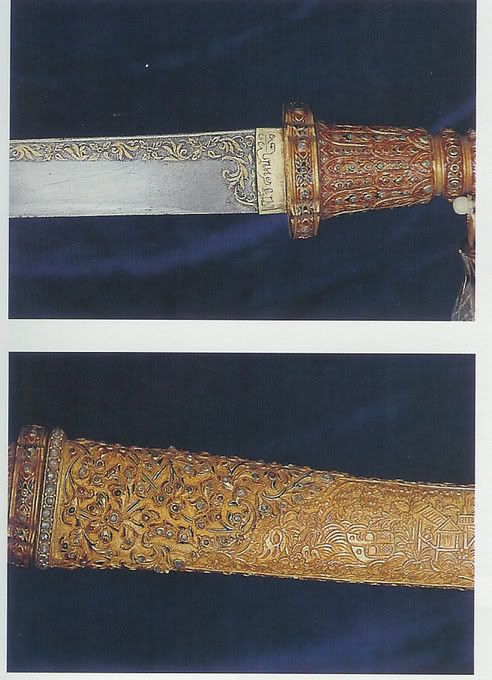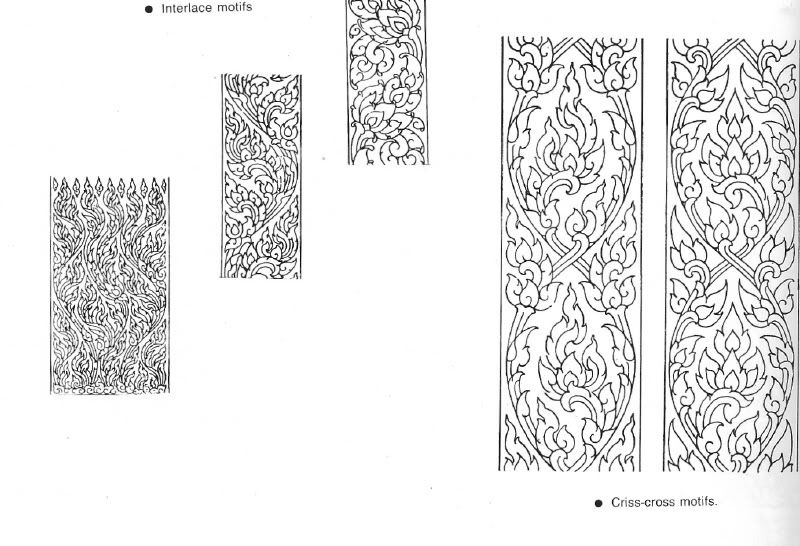
 |
|
|||||||
 |
|
|
Thread Tools | Search this Thread | Display Modes |
|
|
|
|
#1 |
|
Member
Join Date: Dec 2004
Location: 2008-2010 Bali, 1998-2008 USA
Posts: 271
|
A Transylvanian mystery sword : a Sino-Japanese influence possible ?
Years and years ago when I lived Europe, I received as a gift an outstanding catalogue of arms and armour from a fancy German museum , the “Staatliche Kunstammlungen Dresden”. Less years after, when lecturing more profound, I fell upon the most striking (to me...) weapon in the book : A sword made in 1674 Transylvania, exactly dated and marked with the name of the armorer as well (not the owner but the maker) Thomas Kapustran with the lingvistically unchallenging inscription in Latin to be more precise: “ THO. KAPUSINO TRANSYLVAN FECIT 1674 “. A gorgeous, encrusted piece with rows of amethyst gems flanked by the golden plate with inscription and a guard enameled with floral arabesques on a turquoise blue background. All that is obviously nothing that cannot normally take place in 1674 Transylvania when making a sword but the fact THAT IS SO OBVIOUSLY LIKE A JAPANESE SWORD IN SHAPE is what throws me off, is it quiet striking to anyone that? I have not seen the sword in reality but even the German catalogue mentions the “samurai look alikelesness” as the first words in its title and description are: “ Sabel mit Scheide in Form japanischer Samuraischwerter”. All I have is a picture reproduced from the book and the two close ups of same photo of the guard and the handle. Length: 91 cm Blade: 77 cm Weight: 1350 grams Scabbard: 340 g Thomas Kapustran was a fairly known Transylvanian armourer and jeweler with a atelier in the city of Klausenburg (known today as Cluj Napoca, Romania) DEAR LEAGUE OF EXTRAORDINARY GENTLEMEN, LET THE BRAINSTORM BEGIN ! Oher related notes: Timeline: at the times of making this sword the ruler of Transylvania was Michael Apafi (1661-1690) appointed by Turks as vassal prince (but still independent), a man that in order to preserve the independence was direct allied and partner of Ottoman commander Ali Pascha and the famous French "King Sun” Louis XIV, he was also mingling with Polish court and taking sides against Habsburg Austria. Image reference and bibliography: Historisches Museum, Staatliche Kunstsammlungen by Johannes Schobel - page 16 and photo # 21 - (see I am really trying to get better at this, Wolviex and Jim, go ahead and laugh at me...) 
Last edited by Radu Transylvanicus; 29th April 2005 at 11:15 AM. |
|
|

|
|
|
#2 |
|
Member
Join Date: Dec 2004
Location: 2008-2010 Bali, 1998-2008 USA
Posts: 271
|
Between 1543 until 1650 In Japan took place what was called the "Nanban Period" where foreigners were allowed to enter the the country, most of them merchant visitors from China, Holland, Spain, Portugal and England... That until the feudalist politics initiated the ,,Seclusion Laws" that forbided almost any foreigner to enter Japan and the country become completely isolated for centuries... (The Wikipedia Encyclopedia)
The same Wikipedia Encyclopedia article continues : "One thing the Japanese were definitely interested in was barbarian guns. The first three Europeans to reach Japan were Portuguese and came on a Chinese ship to the southern island of Tanegashima, and they had arquebuses and ammunitions with them. At that time, Japan was right in the middle of a huge civil war called the Sengoku period (Period of the country at war). Strictly speaking, the Japanese were already familiar with gunpowder (invented by, and transmitted from China), and had been using basic Chinese guns and cannon tubes called Teppō (鉄砲 Lit.”Iron cannon”) for around 270 years before the arrival of the Portuguese. The Portuguese guns however were light, had a matchlock firing mechanism and were easy to aim with." I realise of course the enormity of distances and how historicaly separated European Transylvania and insular Japan are but here is a theory for the start we can evolve by reading the above ! All that in case it was inspired by Japanese and not a Chinese sword ! Last edited by Radu Transylvanicus; 29th April 2005 at 11:04 AM. |
|
|

|
|
|
#3 |
|
Member
Join Date: Nov 2004
Location: USA
Posts: 1,725
|
Absolutely beautiful, Radu, and a mystery as well! Can you post any photos of the blade?
|
|
|

|
|
|
#4 |
|
Arms Historian
Join Date: Dec 2004
Location: Route 66
Posts: 9,951
|
Outstanding Radu !!!
 Thats what we're talkin' about!!! Thank you. This is really a fascinating mystery and cant wait to get this one going......as Holmes always said......"the games afoot"!!! ("The Return of Sherlock Holmes" 1904, 'The Adventure of the Abbey Grange' by Sir Arthur Conan Doyle). Ahem, ahem  Seriously, nicely done! Best regards, Jim |
|
|

|
|
|
#5 |
|
Member
Join Date: Dec 2004
Location: 2008-2010 Bali, 1998-2008 USA
Posts: 271
|
Again, unfortunatelly, that is the only photo I have and you see everything there is to it... wish I had pictures of the blade further but not so far ... Is there a chance anyone could dig for another catalog of Dresden Historical Museum (they made quite a few types and editions, I have another one on their firearms...) or maybe someone with a large library, someone in Europe can request another image of it, someone from the Krakow museum for example,
 with ties .... with ties ....Again the museum is: Staatliche Kunstsammlungen Dresden and the section of the establishment where the sword resides is : Der Rüstkammer (The Armoury)... they also have a Jagereikammer (The Hunting Chamber) and a Harnischkammer (The Equine Hall). Here is a link of the on-line Rüstkammer exponates but unfortunatelly the sword is not one of them so far but it has a lot of interesting things, even a keris... After clicking the link, look for the last icon on the first row to get to you the Armoury (Rüstkammer) image gallery: http://bildarchiv.skd-dresden.de/skddb/Start.jsp If I could only see the blade we might even go as far as saying that it was inspired by a dha , wouldn't that be something ? Last edited by Radu Transylvanicus; 29th April 2005 at 11:07 AM. |
|
|

|
|
|
#6 | |
|
Member
Join Date: Dec 2004
Posts: 987
|
Quote:
As an interesting side-note, the King of Siam gave a Japanese style sword to the U.S. President (I forget who), which is not on display in a corner or the Smithsonian Museum of American History. I will see if I can find a picture on the internet, and if not I'll try and get a photo. It has a beautiful watered steel blade. Later ... I remembered that Dan had posted pictures of the "samurai" Siamese court swords on the old forum. Note the similarity in the handles.  The thread is here |
|
|
|

|
|
|
#7 |
|
Member
Join Date: Dec 2004
Location: What is still UK
Posts: 5,807
|
I may well be talking out of my hat, but the flowers look like Dutch enamel painting,the Dutch were the main early european traders with Japan.Tim
|
|
|

|
|
|
#8 | |
|
Member
Join Date: Dec 2004
Location: Poland, Krakow
Posts: 418
|
Quote:
|
|
|
|

|
|
|
#9 |
|
Member
Join Date: Dec 2004
Location: Houston, TX, USA
Posts: 1,254
|
Yes, Tim; that's probably the best known European folk art flower pottery of this sort, at least in N America. You seem to have posted while I was in a long mid-edit smoke and cartoon break
 I once had the coolest bee broken off of a pot that a river gave to me; I definitely agree to the resemblance, and the merchantile connection seems perhaps meaningful too; thanks. What I'm unsure of is if the style is definitely Dutch, or if that's only its usual N American attribution. Similar work seems more widespread to me. The hilt seems to be assembled somwhat jewelry style; are these layers, or essentially large beads of clay? Or is some other surface painted to look like pottery? Questions for the ether............ I once had the coolest bee broken off of a pot that a river gave to me; I definitely agree to the resemblance, and the merchantile connection seems perhaps meaningful too; thanks. What I'm unsure of is if the style is definitely Dutch, or if that's only its usual N American attribution. Similar work seems more widespread to me. The hilt seems to be assembled somwhat jewelry style; are these layers, or essentially large beads of clay? Or is some other surface painted to look like pottery? Questions for the ether............
|
|
|

|
|
|
#10 |
|
Member
Join Date: Dec 2004
Location: 2008-2010 Bali, 1998-2008 USA
Posts: 271
|
I know as I initiated this quest for the origins of this sword that many options are available so I gave the title a very vague origin area: Sino (pan far Eastearn Asian, from China to Indochina) and Japanese and I just wanna say out of pure feeling of guess but pretty strong, however not too founded yet that my take is that the blade is of Japanese origins while the rest was styled by the Transylvanian armorer.
Perhaps the sword, rather a blade, found its way to Transylvania from Japan while fittings were in bad shape or maybe were not acceptable or "opulently rich" enough to please the ownership; obviously judging by the decoration the owner was beyond wealthy... How I wish we had a blade close-up photo ! One thing I do refuse to think, it is that the sword is of completely European facture 100%, without any direct influence, that I would not accept until someone bring some really solid argument or similar examples ! Quick note: the name inscribed Thomas Kapustran or Thomas Kapusi (as the exact Latin inscription mentions) is most likely a Sachsen (Saxon) minority (athe comunity was much larger then in the 17th century, not so much of a minority like nowadays) of Transylvania. So he probably spoke and think in German mostly ... In Transylvania, alongside Romanians (the ruling majority now demographically and politically) there were two Hungarian speaking nations (Hungarians and Szekely (or Secui in Roomanian language)) and two German(ic) speaking nations (Sachsen (or Sashi in Romanian or Saxons in English) and the Schwaben in southwest Transylvania). The first German nation of Transylvania, Saxons, migrated from western Europe in the XIII and XIV century. The second nation, the Schwaben, they were more rurally agricultural folkspeople, started arriving in the 18th century so less relevant for our purposes regards the mysteryous sword from Siebenburgen (the German name of Transylvania, meaning :Seven Fortresses)... Last edited by Radu Transylvanicus; 30th April 2005 at 09:20 PM. |
|
|

|
|
|
#11 |
|
Vikingsword Staff
Join Date: Nov 2004
Posts: 6,293
|
Hi Radu , I think that the sword is of completely European manufacture , but 'with' Asian influence . Why do I think that ? The polish on the blade (what I can see of it
 ) seems very un-oriental , almost chrome like . Also consider the barely apparent grind lines in the steel ; wouldn't a Asian sword show grind lines parallel to the length of the blade ? ) seems very un-oriental , almost chrome like . Also consider the barely apparent grind lines in the steel ; wouldn't a Asian sword show grind lines parallel to the length of the blade ?
|
|
|

|
|
|
#12 |
|
Member
Join Date: Nov 2004
Location: USA
Posts: 1,725
|
Browsing an old thread trying to scratch the itch tickling my brain, I came across these photos posted by Dan:
 Ratanakosin (late 18th century-mid 20th century) Thai darb.  Ratanakosin Thai darb.  Thai vegetal motifs.  Thai vegetal motifs. I post these for consideration and discussion. http://www.vikingsword.com/ubb/Forum1/HTML/002442.html |
|
|

|
|
|
#13 |
|
Vikingsword Staff
Join Date: Dec 2004
Location: The Aussie Bush
Posts: 4,203
|
I've been watching this thread and doing some reading of old materials, including the excellent threads by Dan Wilke which Andrew has referenced.
IMHO this lovely sword is a European's synthesis of what an oriental style sword would be. The disk guard is a composite of Japanese and Chinese styles, with decorations that have a strong SE Asian flavor (as evidenced by the materials that Andrew has linked). The handle also seems a composite, being closer to Chinese than Japanese in form and perhaps artistic design. The "habaki" has a purely Japanese heritage, AFAIK. With such a profusion of Oriental influences, this strikes me as one man's impression of what an oriental sword of distinction might look like. There is no need to suspect the sword maker ever saw a real Japanese sword, much less handled one. He would only need some basic descriptions, and perhaps a few line drawings or decorations on ceramics to guide the art style, and the rest could be left to the creativity of the designer and fabricator of the sword. That this is work of the highest quality for its time is not disputed. But I'm going to agree with Rick and say that this is entirely a European creation. I don't think we need to see any more of this sword to reasonably reach that conclusion. The man who signed his name to this sword was a master craftsman, and the sword is testimony to his genius. [BTW, as an aside, the top sword shown by Andrew in the post immediately above has an inscription on the blade written in Thai but the gold collar around the blade that resembles an habaki is signed in Burmese script. It is Thai sword, but seems to have been made by a Burmese. Given the level of animosity between the Thai and Burmish at that time, the use of Burmese crafstmen to create a sword of this quality and distinction seems unusual.] |
|
|

|
|
|
#14 |
|
Member
Join Date: Dec 2004
Location: 2008-2010 Bali, 1998-2008 USA
Posts: 271
|
IAN quote "That this is work of the highest quality for its time is not disputed. But I'm going to agree with Rick and say that this is entirely a European creation. I don't think we need to see any more of this sword to reasonably reach that conclusion. The man who signed his name to this sword was a master craftsman, and the sword is testimony to his genius."
IAN, I like your first phrase better: "a European's synthesis of what an oriental style sword would be" and you must agree once an Oriental sword ( wether Japanese, Chinese or Indochinese) has been the decisional factor and inspiration, basically the muse of this one sword regardless if it is from a visual memory, from a description, from a graphic or artistic resource it ceases to exist as "completely European" but I have a gut feeling that actualy it might actually incorporate real parts from an original Asian sword, I still primarily stick with Japanese heritage IMO and I leave the dha variant as secondary option. And against odds, I really do think we need to see all the sword including scabbard, the grip and one short section of the blade we saw so far are far from enough to basis for a final conclusion, more like stirring the spirits. Its far from over... I would also like to thank everyone of you for the aflux of ideeas, opinions , resources and energy you all well spend in this quest, its a good reminder why I love this Forum so much ! Other things I see: the gems and encrusting has been executed in Transylvania, that I have no doubt, more likely by Thomas Kapustran and am almost certain it is the case with the floral enameling, that is 100% European somehow similar examples can be seen in Ottoman art (again, we are in 1674 Transylvania and Turk Ottoman control weights heavy!) As far as the guard, that is one of the most un-European things on this sword, the resemblance if not similarity with a tsuba is striking and corect me if I'm wrong, you even have the riobitsu holes (look on the second image closer) regardless if purpose or simply fashion. Further you see the fittings welded together the collar (habaki) and spacers (seppa). As far as the disconcern for the blade as being original, remember not all, as a matter of fact very many blades were made of plain non-grain steel named muji, commonly seen in the maru-gitae swords of the New Sword period (1530 to 1868)... Maru gitae is a type of construction with one grade steel used for mass production. Swords of this type ussualy reveal a smooth grainless appearance on their surfaces. Credits: The Samurai Sword - a handbook by J. M. Yumoto . Chapters: Blade construction / Grain pages 94 & 95 Last night I had a sweet dream that myself I dismantled the jewelry from the grip of the sword and there was a big old Kanji signature on the tang there but that was just my dream... I also had this one dream when I was a child that one day I will come to America  ...ahem. ahem ... and last winter I got my Greencard ... ...ahem. ahem ... and last winter I got my Greencard ...
Last edited by Radu Transylvanicus; 1st May 2005 at 12:36 PM. |
|
|

|
|
|
#15 |
|
Member
Join Date: Dec 2004
Location: Houston, TX, USA
Posts: 1,254
|
A/ such relatively homogenous steel would still, at the time, be folded and have grain. B/ equally in Europe as in Japan. C/in the one closeup I see several spots of what I'm pretty sure are folds/lamination.
I disagree that bigger pictures, overall pictures are liable to tell us much more though I'd enjoy them; closeups of the blade would probably be the most useful, and we have them. More would not likely tell us more, except that it might be useful to see the tip of the blade (though if it's "correct" that tells us little, and if it's "incorrect" there is much more variation in old Japanese swords than people often seem to realized, so that tells us little, too.). I think the guard/seppa(and there are similar features on many European swords; sheath lids, oval discs, and leather and felt washers of the seppa shape)/habiki was cast in one piece. I'm not certain, but that's my thinking. Look inside the piercings; look where each flows into the other; I see no join lines, though certainly such can be cleverly hidden. I do not think the silver ring around the edge is a layer; I think it's a ring soldered into a groove. This is guesswork based on what I can see; it could be wrong; those brass coloured flower centers could be rivets, even. (photos.....  ) I still see nothing to argue for an Asian origin for this heavily Asian-influenced object. The Ottoman connection seems interesting, but the handle construction seems European? One thing worth noting is that the blade seems to have a shinogi zukuri cross-section; sabre-bevelled with a (somewhat rounded and indestinct, but present) ridge down the middle(ish) of its width. ) I still see nothing to argue for an Asian origin for this heavily Asian-influenced object. The Ottoman connection seems interesting, but the handle construction seems European? One thing worth noting is that the blade seems to have a shinogi zukuri cross-section; sabre-bevelled with a (somewhat rounded and indestinct, but present) ridge down the middle(ish) of its width.
|
|
|

|
|
|
#16 |
|
Member
Join Date: Dec 2004
Location: Houston, TX, USA
Posts: 1,254
|
Hmmm. I think I do now see layering inside one of the piercings, and the layer line I see delineates the same thickness as seen framing the silve line at the edges. Hmmm. A stacked rivetted guard reminds me most closely of "migration era" German work, which is way out of sphere......
|
|
|

|
|
|
#17 |
|
Member
Join Date: Dec 2004
Location: What is still UK
Posts: 5,807
|
 Note sword.Painting by Harmen Steenwyck,c1640http://img.photobucket.com/albums/v426/jamhappy/Picture.jpg Note sword.Painting by Harmen Steenwyck,c1640http://img.photobucket.com/albums/v426/jamhappy/Picture.jpg
|
|
|

|
|
|
#18 |
|
Member
Join Date: Dec 2004
Location: What is still UK
Posts: 5,807
|
 Notesword.Painting by Harmen Steenwyck,c1640http://img.photobucket.com/albums/v426/jamhappy/Picture. jpg Notesword.Painting by Harmen Steenwyck,c1640http://img.photobucket.com/albums/v426/jamhappy/Picture. jpg
|
|
|

|
 |
|
|